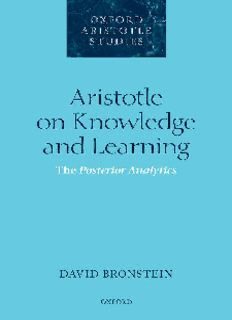Table Of ContentOUPCORRECTEDPROOF–FINAL,24/2/2016,SPi
Aristotle on Knowledge and Learning
OUPCORRECTEDPROOF–FINAL,24/2/2016,SPi
OXFORD ARISTOTLE STUDIES
GeneralEditors
JuliaAnnasandLindsayJudson
PUBLISHEDINTHESERIES
PassionsandPersuasioninAristotle’sRhetoric
JamieDow
HowAristotlegetsbyinMetaphysicsZeta
FrankA.Lewis
ThePowersofAristotle’sSoul
ThomasKjellerJohansen
AristotleontheApparentGood
Perception,Phantasia,Thought,andDesire
JessicaMoss
Teleology,FirstPrinciples,andScientificMethodinAristotle’sBiology
AllanGotthelf
PriorityinAristotle’sMetaphysics
MichailPeramatzis
DoingandBeing
AnInterpretationofAristotle’sMetaphysicsTheta
JonathanBeere
AristotleontheCommonSense
PavelGregoric
Space,Time,Matter,andForm
EssaysonAristotle’sPhysics
DavidBostock
AristotleonTeleology
MonteRansomeJohnson
TimeforAristotle
PhysicsIV.10–14
UrsulaCoope
PoliticalAuthorityandObligationinAristotle
AndresRosler
OUPCORRECTEDPROOF–FINAL,24/2/2016,SPi
Aristotle on Knowledge
and Learning
The Posterior Analytics
David Bronstein
1
OUPCORRECTEDPROOF–FINAL,24/2/2016,SPi
3
GreatClarendonStreet,Oxford,OX26DP,
UnitedKingdom
OxfordUniversityPressisadepartmentoftheUniversityofOxford.
ItfurtherstheUniversity’sobjectiveofexcellenceinresearch,scholarship,
andeducationbypublishingworldwide.Oxfordisaregisteredtrademarkof
OxfordUniversityPressintheUKandincertainothercountries
©DavidBronstein2016
Themoralrightsoftheauthorhavebeenasserted
FirstEditionpublishedin2016
Impression:1
Allrightsreserved.Nopartofthispublicationmaybereproduced,storedin
aretrievalsystem,ortransmitted,inanyformorbyanymeans,withoutthe
priorpermissioninwritingofOxfordUniversityPress,orasexpresslypermitted
bylaw,bylicenceorundertermsagreedwiththeappropriatereprographics
rightsorganization.Enquiriesconcerningreproductionoutsidethescopeofthe
aboveshouldbesenttotheRightsDepartment,OxfordUniversityPress,atthe
addressabove
Youmustnotcirculatethisworkinanyotherform
andyoumustimposethissameconditiononanyacquirer
PublishedintheUnitedStatesofAmericabyOxfordUniversityPress
198MadisonAvenue,NewYork,NY10016,UnitedStatesofAmerica
BritishLibraryCataloguinginPublicationData
Dataavailable
LibraryofCongressControlNumber:2015948868
ISBN 978–0–19–872490–2
PrintedinGreatBritainby
ClaysLtd,StIvesplc
OUPCORRECTEDPROOF–FINAL,24/2/2016,SPi
To Keren
דוִדָלְ ןרֶקֶ
(Psalm132)
OUPCORRECTEDPROOF–FINAL,24/2/2016,SPi
OUPCORRECTEDPROOF–FINAL,24/2/2016,SPi
Table of Contents
Acknowledgements xi
AbbreviationsofTitlesofAristotle’sWorks xiii
Introduction
General Introduction 3
1. Meno’sParadox 4
2. TheOrderofInquiry 6
3. Nous 7
1. Meno’sParadoxandthePriorKnowledgeRequirement 11
1. Meno’sThreeQuestions 11
2. Socrates’sDilemma 13
3. Meno’sandSocrates’sPriorCognitionRequirements 14
4. AristotleonLearning:thePriorKnowledgeRequirement 15
5. AristotleonKnowledge 16
6. PriorKnowledgeofWhat? 21
7. PriorCognitionandPriorKnowledgeinPlatoandAristotle 22
8. SimultaneousLearninginAPo1.1 23
9. Meno’sParadoxinAPo1.1 25
Conclusion 27
Part I. Learning by Demonstration
2. LearningbyDemonstration 31
1. ThePrevailingView 32
2. TextualEvidence 33
3. ScientificKnowledgeandDemonstration:APo1.2 35
4. WhatisLearningbyDemonstration? 39
Conclusion 42
3. Belonging‘InItself’andAristotle’sTheoryofDemonstration 43
1. Belonging‘InItself’(Kath’Hauto):APo1.4 43
2. InItself :DemonstrableAttributes 46
2
3. InItselfAccidents:DemonstrableAttributes 47
4. TwoModelsofDemonstration 48
4. ScientificKnowledgeandDemonstration 51
1. Non-DemonstrativeScientificKnowledge(Nous) 51
2. ScientificKnowledgeandExplanation 57
3. Epistēmē,Nous,andLogos 58
4. TheObjectsofScientificKnowledge 58
OUPCORRECTEDPROOF–FINAL,24/2/2016,SPi
viii TABLEOF CONTENTS
5. Scientificvs.Non-ScientificKnowledge 60
6. TheRequirementsforPrinciplesofDemonstration 61
7. ThePriorKnowledgeRequirementforLearningbyDemonstration 63
8. LearningbyDemonstration,Revisited 64
Conclusion 66
Part II. Learning by Definition
5. LearningbyDefinition:Introduction 69
1. SomePreliminaries 70
2. LearningbyDemonstrationandbyDefinition 72
6. InquiryinAPo2.1 74
1. TheFourQuestionsofInquiry 74
2. InquiryandScientificKnowledge 76
3. KnowledgeinAPo2 77
4. FromNon-ScientifictoScientificKnowledge 78
5. TheObjectsofInquiry 80
6. TheStagesofInquiry 83
7. Meno’sParadox 84
7. InquiryinAPo2.2 89
1. SearchingfortheMiddleTerm 89
2. AttributeQuestions 91
3. TheCausalandDefinitionalConstraints 92
4. Meno’sParadox 93
5. TheCausalConstraintforAttributes 95
6. TheDefinitionalConstraint:IntroducingCausallyComplexEssences 96
7. AttributesandSubjects 99
8. TheATerm 101
9. AMissingATerm? 102
10. DefinitionandExplanation 103
11. Subject-FocusedInquiry 104
12. EssenceandMiddleTerm 106
Conclusion 107
8. TheSocraticPictureoftheOrderofInquiry 108
1. TheIntuitionistPicture 108
2. TheExplanationistPicture 112
3. TheSocraticPicture 114
4. ThreeMethodologicalPassages 120
5. BetterKnownByNatureandToUs:Explanation,Conviction,andNous 127
6. AnObjection 129
9. Cause,Essence,andDefinition 131
1. CausesthataretheSamevs.CausesthatareDifferent 132
2. CauseandEssence 134
3. TheTwoTypesofCauseinAPo2.9 135
OUPCORRECTEDPROOF–FINAL,24/2/2016,SPi
TABLEOF CONTENTS ix
4. HowEssencesareDiscovered 137
5. APo2.10:Definition 138
6. NominalAccountsinAPo2.10 141
Conclusion 143
10. DiscoveringCausallyComplexEssences:APo2.8 144
1. ThePuzzlesofAPo2.3–7 144
2. TheArgumentofAPo2.8,93a3–15 147
3. TheEssence-RevealingDemonstration 150
4. Inquiry,Discovery,andPriorKnowledge 153
5. KnowingPartoftheEssence 156
6. KnowingPartofx’sEssencewithoutKnowingthatxExists 157
7. FirstRoutetoKnowledge:Stages3to4 159
8. FirstSolutiontoMeno’sParadox 162
9. InquiringwithoutanATerm 163
10. DiscoveringtheEssence-RevealingDemonstration:Stages4to5 164
11. TheTwoModelsofDemonstrationinAPo2.8 166
12. SecondRoutetoKnowledge,SecondSolutiontoMeno’sParadox 166
Conclusion 169
11. Subject-KindsandtheirExistence 170
1. Primaryvs.SubordinateSubject-Kinds 171
2. Subject-Kindsvs.DemonstrableAttributes 173
3. SubordinateSubject-Kindsvs.DemonstrableAttributes 175
4. DemonstratingAttributes:TeachingbyDemonstration,Part1 177
5. Teachingvs.Inquiring 182
6. DemonstratingSubordinateSubject-Kinds:Teachingby
Demonstration,Part2 183
7. DiscoveringtheExistenceofSubordinateSubject-Kinds 185
8. DiscoveringtheExistenceofPrimarySubject-Kinds 187
12. DiscoveringCausallySimpleEssences:APo2.13 189
1. Division,Definition,andExplanation 190
2. DiscoveringtheEssencesofSubject-Kinds 196
3. Genus,Differentia,andDivision:AnOverview 197
4. ObjectionstoDivision:APo2.5and6 199
5. TheDAttributeRule 199
6. DivisionIntroduced 204
7. ExhaustiveDivision 206
8. CorrectlyDividingaGenus 207
9. PreliminaryConclusions 210
10. Inquiry,Division,andMeno’sParadox 211
11. DefiningbyDivision:Conclusions 218
12. DiscoveringtheEssencesofPrimarySubject-Kinds 219
Description:'All teaching and all intellectual learning come to be from pre-existing knowledge.' So begins Aristotle's Posterior Analytics, one of the most important, and difficult, works in the history of western philosophy. David Bronstein sheds new light on this challenging text by arguing that it is coheren

